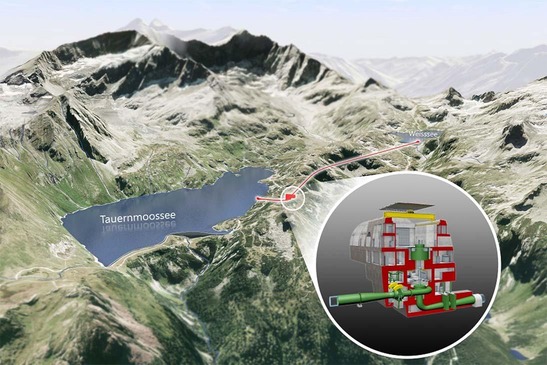
100% renewable electricity
In future the new Tauernmoos power plant will be one of the most important cornerstones for a sustainable, demand-oriented supply of traction current from hydroelectric power. Thus, performance peaks in the traction power grid will be covered even more efficiently.
Facts & Figures
-
- Pumped-storage hydroelectric power plant
- Output 170 Megawatt (MW)
- Annual energy generation 460 Gigawatt hours (GWh)
- High technological and environmental standards
-
Milestones
- 2007: Start of planning
- 2012: Positive UVP notification
- 2013: Excavation of the exploration tunnel to the Tauernmoos cavern
- 2020: Start of construction
- 2025: Planned commissioning
Optimal use of the 220 metre height difference between the reservoirs
The two reservoirs Tauernmoossee and Weisssee were constructed in the upper Stubachtal valley (municipality of Uttendorf) in the Hohe Tauern National Park, in the first half of the century. The Tauernmoossee has been used with the Enzingerboden power plant to generate electricity (output 80 MW) ever since. The Weisssee, which is 220 metres higher, continues to serve as a pre-storage basin only. The drop height between Weisssee and Tauernmoossee has never been used. The new pumped-storage power station with two 85 MW turbines also enables this height difference of the reservoirs to be used to generate electricity for powering trains.

Ideal complement through use of existing infrastructure
Already in the first half of the last century, the two storage lakes Tauernmoos- and Weißsee were built in the Stubach valley. The new Tauernmoos pumped storage power plant complements this existing infrastructure. As a result, the consumption of natural resources can be reduced to an absolute minimum. The Tauernmoos power plant is therefore the ideal complement to the existing group of power plants in the Stubach Valley.
The four existing traction power plants in Salzburg's Stubach Valley form ÖBB's largest and most powerful power plant group. Already today, every fifth train in the network runs on traction current from the Stubach Valley.
In addition to water law and nature conservation, the EIA decision of the province of Salzburg includes all permits required for the construction of the power plant, including those under the Railway Act.



